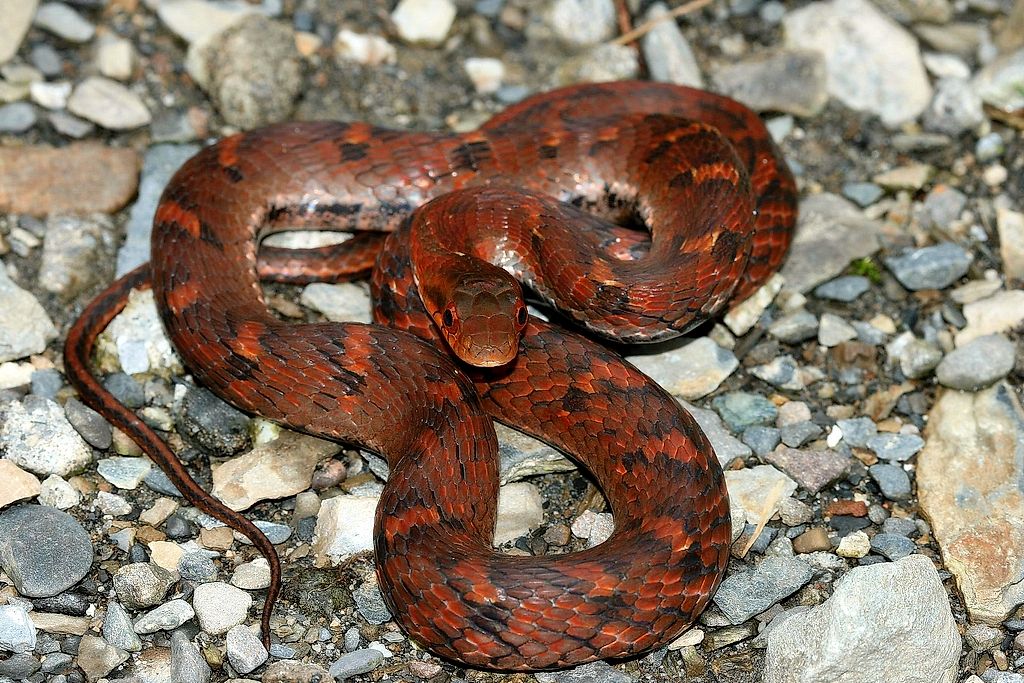Pseudoxenodon stejnegeri stejnegeri
(Stejneger's) Mountain Keelback
史丹吉氏斜鱗蛇 (shi3dan1ji2shi4xie2lin2she2)
Status: Not protected
Non-venomous
Family
Colubridae, subfamily Natricinae
Max. length
90 cm
Occurrence in Taiwan
Throughout Taiwan, at altitudes of 1000-2500 m. Not very common.
Global Distribution
Endemic to Taiwan.
Description
Small snake; total length up to 90 cm. There are 15-21 (17 at mid-body) rows of keeled
scales; anteriorly dorso-lateral scales are oblique. Head is oval,
triangular and distinct from neck; body is slightly stout; tail is long.
Eye is medium to large size; iris is light flesh-colored with flecks of
black, and darkened in lower two-thirds; pupil is round, black, surrounded
by narrow ring of light flesh. Tongue is maroon, fork tips may be gray. It
has enlarged rear fangs. The color of upper surface is extensively varied
among individuals, including grey, green, yellow, orange, brown, and
purple. A dark stripe extends from eye to base of jaw, and usually a
reddish or black chevron sits on the nape, with its apex pointing toward
the head. There are light bands along the vertebral ridge and dark squares
on the sides of the bands; a light mid-dorsal stripe runs along the tail.
Ventral surface is whitish anteriorly, gradually tinted with pinkish and
may be mottled with black or white pigment in following part of body; the
black spots aggregating on sides of the ventrals usually form a
longitudinal stripe. The ventrals in anterior body may also have scattered
quadrangular marks of black pigment which are irregularly arranged on
sides. Anal scale is divided and subcaudals are paired.
Biology & Ecology
This cathemeral (diurnal and nocturnal), opistoglyphous (= rear-fanged, see footnote (1))
snake inhabits humid mountain areas, in particular the forest floor close to rivers and creeks,
where it preys on frogs and salamanders. P. stejnegeri is oviparous, but little else is known
about its reproduction processes. When threatened, the snake may rear its head and neck, and
expand its neck laterally, similar to a cobra, but not as wide.
The snake's dorsal coloration is extensively varied among individuals, including grey, green, yellow,
orange, brown, and purple.
Etymology
Pseudoxenodon: Greek; pseudo means "fake" ; xenodon (lit. "alien tooth") is a family of South
American snakes also known as "false pitvipers".
stejnegeri: after Leonhard Hess Stejneger, (1851-1943), a Norwegian-born herpetologist who moved
to the US in 1881 and became curator of reptiles at the Smithsonian Institution in 1889.
The Chinese name 史丹吉氏斜鱗蛇 (shi3dan1ji2shi4xie2lin2she2) means "Stejneger's (史丹吉氏) keel-scale (斜鱗) snake (蛇).
Footnotes
(1) "Opisthoglyphous snakes are similar to aglyphous (fangless) snakes, but possess weak venom,
which is injected by means of a pair of enlarged teeth at the back of the maxillae (upper jaw).
These "fangs" typically point backwards rather than straight down, possess a groove which channels
venom into the prey, and are located roughly halfway back in the mouth, which has led to the
vernacular name of "rear-fanged snakes". (Source)
Further Info








